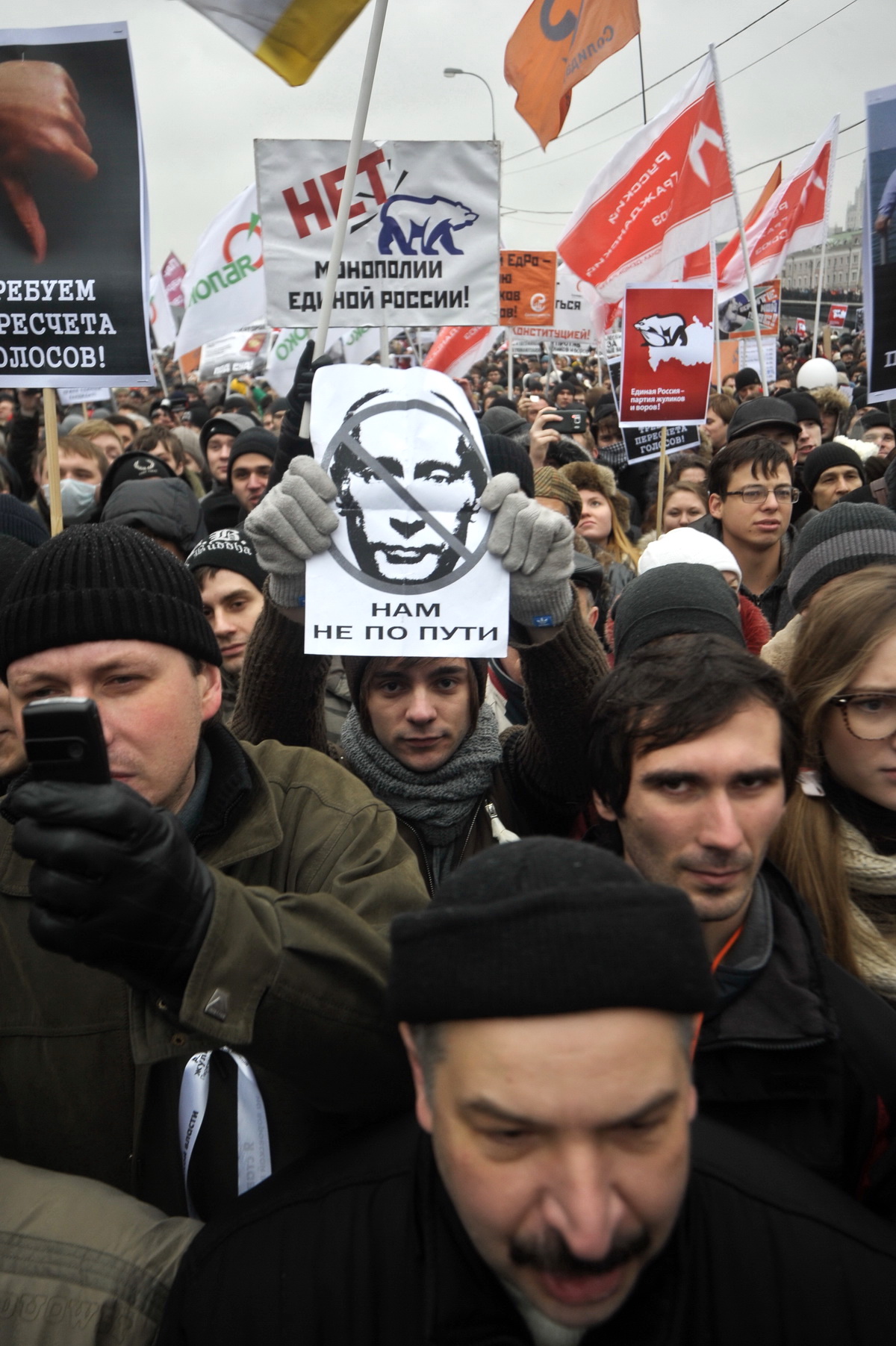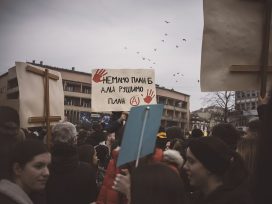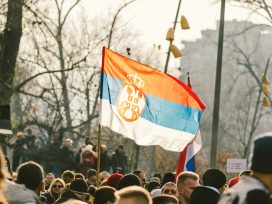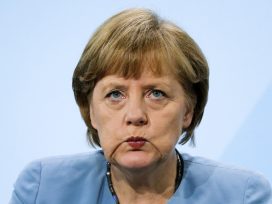On 19 August 1991, Muscovites were woken up by tanks rolling through the streets. In the early morning, armoured columns had taken up positions in the centre of the Russian capital. It was the beginning of the coup d’état organized by the KGB and the military. Unhappy with Gorbachev’s reforms, they wanted to roll back history and restore the Soviet order. They started by arresting Gorbachev in Crimea – the KGB cut off Gorbachev’s personal phone line from his vacation compound, followed by the local phone lines. Then they placed tanks on the streets and introduced censorship, sending KGB officers to the editorial offices of the newspapers and radios.
But the putschists completely overlooked the fact that the Soviet Union was already connected to the outside world via the nascent internet. At the end of 1990, the first Soviet network Relcom (RELiable COMmunications) had reached seventy cities and was used by over four hundred organizations, including universities, research institutes, stock and commodity exchanges, high schools and government agencies. It had a leased line to Helsinki, which connected Relcom with the global internet.
The putschists also failed to isolate Boris Yeltsin, a charismatic leader, and a group of his supporters. Yeltsin made it to the Russian White House – The House of the Russian Parliament – and started organizing resistance.
In the early hours of the first day of the putsch, a guest knocked on the door of the office of the Relcom network on Moscow’s Ovchinnikovskaya Embankment and introduced himself as a representative of the Yeltsin team. He said he was looking for commercial offices that had Xerox machines to help them disseminate Yeltsin’s appeals. ‘Forget about Xerox’, he was told. ‘We are connected with all big cities, as well as with the West.’ The Yeltsin man slipped away without another word. Then another Yeltsin envoy appeared at the building. This second envoy brought copies of Yeltsin’s statements and asked Relcom to distribute them through its channels.
The internet connection to cities outside Moscow and beyond the borders of the Soviet Union proved extremely important in circulating statements from Yeltsin and other democrats. Soon Relcom was disseminating news releases from the independent Soviet news agency Interfax, along with news from Echo Moskvy radio, the Russian Information Agency, Northwest Information Agency (Leningrad), and Baltfax – all of which were outlawed by the putschists.
But the internet connection was even more important in another respect. On the first day of the coup, someone in Relcom’s team came up with the idea – referred to as ‘Regime No.1’ – of asking all subscribers to look out the window and describe exactly what they saw – just the facts, no emotions. Very soon, Relcom had obtained a kaleidoscopic picture of what was happening throughout the country and disseminated the eyewitness accounts along with news reports. It became clear that the tanks and troops were present in only two cities – Moscow and Leningrad – and that the coup would not succeed. Indeed, after three days the putschists gave up and surrendered to Yeltsin’s people.
This was very first time in history that the internet had contributed to a democratic cause and not only been used as a means of spreading information. It enabled participation in what we would now call ‘information crowdsourcing’. It was a very bright moment for the internet. But there was also a downside that very few people noticed back in 1991.
First, ‘Regime No.1’ was the work of a tiny group of people, with mostly the same educational and professional backgrounds, living in a country that was very authoritarian. It was not some sophisticated democratic procedure, but a very rough idea of citizens’ participation. Second, ‘Regime No.1’ was based on the assumption that all the users of Relcom were trustworthy, since there was no way of checking the information that they reported. As more users joined in, the concept would no longer be workable. So how long could this concept survive?
Escapism
In the 2000s, Russians joined the internet in large numbers. This was the time that Vladimir Putin came to power and changed how politics was done in the country. The major rule of the new system he established was directed at the fast-growing and dynamic middle class. It was quite simple: I keep taxes low to help you make money, I guarantee your security by crushing the militants in the North Caucasus, and I keep the borders open and provide you with freedom of movement. In return, you give up any participation in Russia’s political life and you don’t ask any questions about the Kremlin’s methods – in mainland Russia or Chechnya. And I don’t even ask you to go to vote at elections, I’m fine with the low turnout. Basically, it was a trade-off: the middle class was given private freedoms in return for forgetting about public freedoms.
The majority of the middle class accepted the deal. And the internet was part of the problem.
In the mid-2000s, many print journalists lost their jobs and television channels were put under the Kremlin control. This was part of Putin’s strategy of cleansing the public space of troublemakers. For many people, the internet became the only place where it was possible to express one’s opinions. Reporters turned into bloggers. The overwhelming majority of them were highly critical of Russian domestic policy. Some enjoyed thousands of followers. But they were not the most popular bloggers. A new subculture was born in Russia – a ‘net culture’, largely based on LiveJournal, Russia’s top blogging platform in the 2000s. The most prominent proponents of ‘net culture’ were apolitical and cynical. They scoffed and mocked both official politics and the opposition, as well as any political institution in the country – from trade unions to journalists. In a way, it was an anti-establishment movement – and it suited Putin perfectly.
In fact, it was a culture of escapism, and it contributed significantly to lowering the level of political participation among the new generation of Russian citizens – including the most technologically advanced and, on the surface, most westernized part of it.
Out of touch with political reality and dismissive and distrustful of the traditional media and other conventional means through which to navigate the life of the country, many among this westernized urban middle class turned to popular bloggers as something like ethical guides. The problem was, well… that bloggers failed to develop any kind of professional ethics. And this was not lost on the Kremlin. Putin’s people quickly co-opted a number of prominent bloggers, promising them access to high-ranking officials.
Then, on 17 August 2009, an accident occurred at the Sayano-Shushenskaya power station on the Yenisei River in Siberia – the largest hydroelectric plant in Russia – in which seventy-four people were killed in a transformer explosion caused by the flooding of the engine and turbine rooms. Worried by media coverage of the catastrophe, the Kremlin tested a new public relations approach. A journalist from Interfax, a traditional news agency, was expelled from the Sayano-Shushenskaya Station after writing critical reports and the popular blogger Rustem Adagamov, a.k.a. Drugoi (‘another’), invited to cover the relief operation. He accepted, reporting favourably for the authorities. Adagamov was later invited to the Kremlin press pool, an elite group given special access to the president. This he also accepted. Ironically, a few years later, Adagamov was forced to leave the country – becoming one of the new wave of Russian political exiles.
In short, by the end of the first decade of the new millennium, the most culturally and economically active part of Russian society – the urban, westernized middle class – was completely unprepared for any kind of political participation. For much too long, they had preferred to sit in front of their laptops sharing jokes and memes. The new Russian opposition grasped the problem and Alexei Navalny was the one who thought he found a solution.
Throughout the 2000s, Navalny had been politically active in various ways. He had joined the democratic and socialist party Yabloko, which expelled him for having xenophobic views, and had founded a nationalist movement called Narod (‘People’). Neither had brought him prominence or popularity. He found the magic formula in the spring of 2008, when he bought stocks of the biggest oil and gas companies, including Rosneft, Gazprom and the oil transport monopoly Transneft, all of which were partially owned by the state. This gave him access to information about the companies’ activity, which would allow him to sue their leadership for corruption. In November 2010, Navalny posted on his blog details about his investigation into corruption in Transneft during the construction of a pipeline from Eastern Siberia to the Pacific Ocean. He had found that 120 billion rubles had disappeared and posted scans of documents he had obtained. The next day he woke up as the most popular muckraker in Russia.
Navalny understood that he needed to get a cynical population to rally for change. ‘You have to propose to people the comfortable way of struggle’, he told Emily Parker, an American scholar and former State Department policy advisor, in 2010. (Parker later wrote the book Now I Know Who My Comrades Are, an excellent study of the role of technology in the Arab Spring and Moscow protests.)
‘In other words, now’s not the time to call people into the streets,’ wrote Parker of Navalny’s approach. ‘It would be far more effective to say, please, just fill out this online form.’ And that’s exactly what Navalny did. Encouraging lazy, noncommittal internet activism, which some western commentators call ‘slacktivism’, was part of Navalny’s masterplan. He wanted to show Russians that they could fight corruption from the convenience of their living rooms.
At the very least, this strategy made Navalny the most popular political blogger in the country. But it hardly prepared Russian society for the upsurge of the political activity that began in late 2011.

Moscow rally at the Bolotnaya square (2011). Source: Wiki Commons
Protests
In December 2011, Moscow was hit by a wave of protests. The urban middle class felt cheated by Putin, who had announced his plan to return to the Kremlin for a third term as president. The Medvedev ‘thaw’ was over. Angered Muscovites, among them bloggers (and Adagamov) – then known as Moscow’s creative class – took to the streets.
At the rallies, many held humorous placards and made jokes about Putin and Medvedev. There was a carnivalesque atmosphere among the crowd during the harsh winter of 2011–2012, the high-point of the protests.
But it was immediately clear that something was wrong. It was not political parties, trade unions, or charismatic leaders that had driven Muscovites to demonstrate in the tens of thousands. Rather, they had organized themselves via Facebook, following the example of the Arab Spring. Most of the protesters were not prepared to support a political group or party.
To those with first-hand experience of organized protest in Russia the late 1980s and 1990s, the new protesters appeared to be an impossibly naive crowd with only very primitive ideas about what they wanted to achieve. The protesters responded enthusiastically to the popular thriller-writer Boris Akunin, while a blogger with huge following on LiveJournal called from the stage for the creation of ‘The Party of Honest Russians’. The years of political ignorance promoted on the blogosphere had surely contributed to the effect.
But there was a bright side, too. Muscovites overcame their reluctance to participate in politics. Many joined groups, both online and offline, devoted to monitoring the Duma and the presidential elections, to make sure they were fair and legitimate. Some protesters, angered by the violence of the riot police, launched groups to monitor detentions of protesters. This became a very effective tool for freeing people who had been arrested and for holding the police accountable – mostly thanks to people who texted and sent messages on Facebook, reporting the arrests.
Participation became about crowdsourcing money for the protests rallies – a proper rally needed a good sound system and big screens, not to mention a stage. Crowdsourcing was organized via Yandex.Money, the Russian version of PayPal. The system worked pretty well: organizers announced on Facebook on 18 December 2011 that they needed 3 million rubles, (about $100,000) to fund the next big rally. The sum was collected just in four days.
Putin won the election in March 2012 and returned to the Kremlin. But the defeat of the opposition was largely self-inflicted. The protests had begun in response to the fraudulent parliamentary elections, however the opposition itself didn’t have a political party to represent its demands. Nor did it have a presidential candidate.
With the hindsight, however, the protesters of 2011–2012 were lucky in one respect. The pro-Kremlin trolls tasked to disrupt online discussions by posting inflammatory or off-topic messages missed the mark, albeit for purely technical reasons. Trolling had been a tactic used by the Kremlin since the 2000s against liberal and independent media and bloggers. It had mostly been developed on the platform LiveJournal – where it was possible to post anonymous posts, an option the trolls exploited to the fullest. But by the time of the protests, many Muscovites had moved to Facebook, VKontakte and Twitter. This caught the trolls completely off guard.
But the advantage couldn’t last for long, and it didn’t.
The time of the trolls
The West woke up to the threat of Kremlin trolls in 2016, however it had already been very damaging in 2014–2015. The Ukraine crisis saw the deployment of trolls to Facebook and VKontakte, as well as YouTube and Twitter. The operation was directed at Ukrainians, but it was the Russian people that were hit the hardest. The Kremlin propaganda campaign was based on three points: the legacy of the Second World War and the image of the Soviet Union as saviour of the world from fascism; grievances against the West; and fears of another bloody revolution. These produced stories such as that of the child crucified by Ukrainian fascists, who had come to the East of the country after the Maidan revolution, supported by an ungrateful and treacherous West.
By 2014–2015, then, the internet had come very far from being a space dominated by a relatively small group of IT-professionals with similar backgrounds, who observed the tacit and commonly accepted rules of engagement in public debate.
Worse, the internet was no longer the same thing for every user, as it its creators had intended it to be. Because of the hierarchical concept of online ratings, a post or video published by a big corporation or government gets more views in social media than a post by an ordinary user. The traditional concept of public trust, based on the authority and reputation, was thrown out of the window. Instead, tech giants run by CEOs with engineering backgrounds introduced a new concept of trust, based on something they had been taught to believe in – digits and numbers. The more clicks, hits and views you get, the higher the position you receive in the rating – and the more users would see your content.
In western countries, this new concept of public trust was counterbalanced by traditional media. But in Russia, the populace was completely defenceless. Trust in the traditional media had broken down too many years ago. Unable to check the authenticity of the emotional messages pumped at them online, ordinary Russian users not only consumed the message – they began sharing it. At this moment, at the latest, it had become clear that online political participation by ordinary citizens could have a devastating effect. Fake news (always emotional), smear campaigns, and crazy conspiracy theories flooded social media. Given the number of people sharing them, they became prominent enough to be reported by traditional media. At least one person who found a way to use it became president of the United States.
The global platforms were caught off guard. Their concept of trust was based on numbers of hits, views and clicks. They hadn’t envisioned that thousands of legit online users would post and share disinformation. What we’ve seen since then – above all revelations of Russia’s use of Facebook to manipulate public opinion during election campaigns in the US and Europe – is a painful manifestation of the complexity of the phenomenon. The investigation into Russian meddling in the US presidential election showed that trolling was never completely dependent on a technology like bots, nor that it was predominantly about Kremlin employees sitting somewhere in Russia manufacturing anti-Clinton propaganda. Rather, it was ordinary Americans and Europeans that were sharing the messages launched by trolls, and often posting them themselves (messages Russian trolls then went and promoted).
According to Robert Mueller’s indictment, Russia’s trolling operation in the US in 2016 had a monthly budget of only $1.25 million and even at its peak employed only around 80 people. And yet, it was highly effective: Facebook testified that about 126 million Facebook users had seen Russian-linked content. Which means that many people shared this content independently. Some attempts were made to fix the problem. In January 2018, Facebook began prioritizing ‘trustworthy’ news outlets on its stream of social media posts, in order to combat ‘sensationalism’ and ‘misinformation’.
But the concept of public trust is so badly damaged that such attempts are unlikely to become a game changer. For one thing, who these days would trust Facebook to be sufficiently honest, sophisticated and transparent to prioritize news outlets correctly? And why should one delegate the decision on the prioritization of news and news outlets to Facebook? Most importantly, this method cannot deal with the question of what to do when millions of people suddenly start sharing something that is fake or offensive. The vox populi cannot be ignored or banned, even the ugly part of it; and in the brave new world, it cannot be removed from the internet for purely technical reasons.
New Times
Is everything as bad as it seems?
Autumn 2018. The editor-in-chief of the liberal Russian magazine The New Times, Yevgenya Albats, was desperate. Popular but highly critical of the Kremlin, The New Times had hardly survived the last few years. The authorities had taken the magazine off the stands in Moscow’s supermarkets and newsagents, which caused a loss of profit. It had been losing advertisers as a result of intimidation by the Kremlin. Albats had to shut down a print edition of the magazine but, with characteristic stubbornness, had kept up the online edition.
In October, the Moscow court ordered the outlet to pay a fine of 22.3 million rubles (approx. 300,000 euros). She was certain it would kill the magazine. The court ruled that Albats had failed to report properly on how The New Times had spent funding from the Press Freedom Support Foundation, an NGO that the Russian government classifies as a ‘foreign agent’ (despite the fact it was founded by a Russian entrepreneur). Albats claimed that she reported everything correctly, but the court did not take her evidence into account.
‘This is bankruptcy’, she told journalists. This sum of money was equal to the magazine’s annual operating costs and the biggest fine in the history of the Russian media.
Desperate, but not defeated, Albats launched a crowdfunding campaign on Facebook and Twitter. The result surprised both her and Russian liberals, and no doubt the Kremlin, too. The money was entering the magazine’s accounts much faster than anybody thought. On the fourth day, Albats tweeted, ‘We did it!!!!! We can! Thanks to all!!!!!’ They had raised 25.4 million rubles.
The Kremlin’s trolls immediately attacked The New Times, claiming that the money had been transferred by oligarchs, angered by Putin’s politics. But that was not the case. According to Albats, of the more than 15,000 individuals who sent money to magazine’s accounts, there were only five rich people among them. One was the eccentric billionaire Yevgeny Chichvarkin, who lives in exile in London. He contributed one million rubles. Chichvarkin wrote: ‘I want Yevgenya Albats to keep doing her job. But Putin and his friends don’t want it.’ Many people transferred small sums of money like one thousand rubles. Some were witty: ‘I support you, despite the fact that I do not agree with you.’
And many added the note: ‘For press freedom’.








